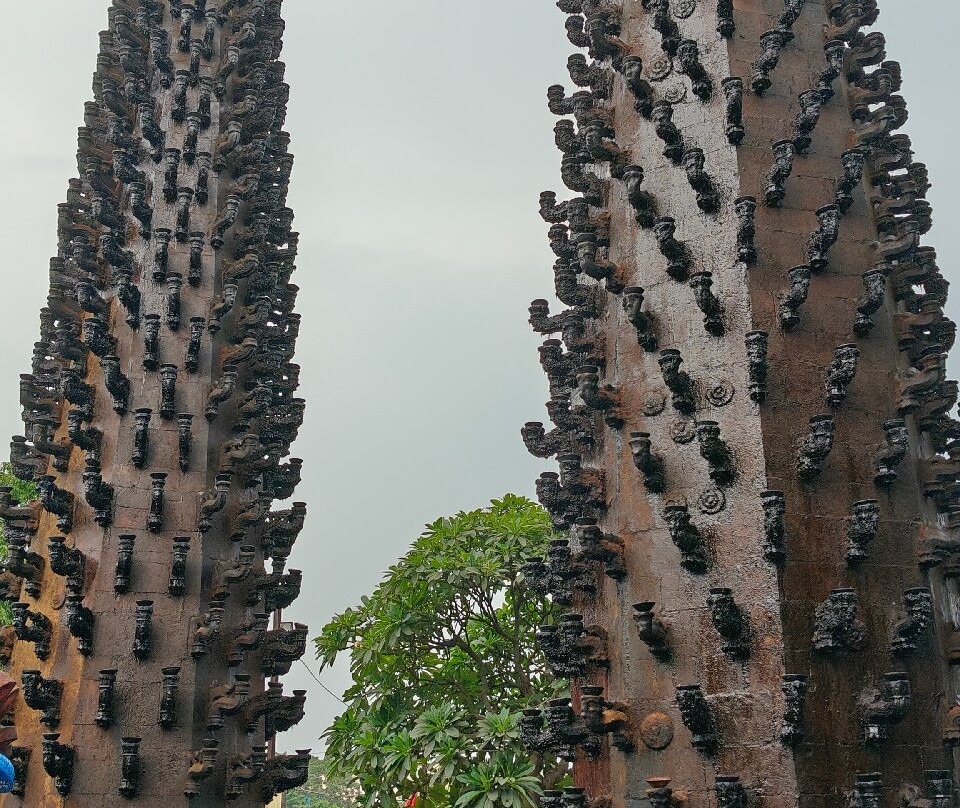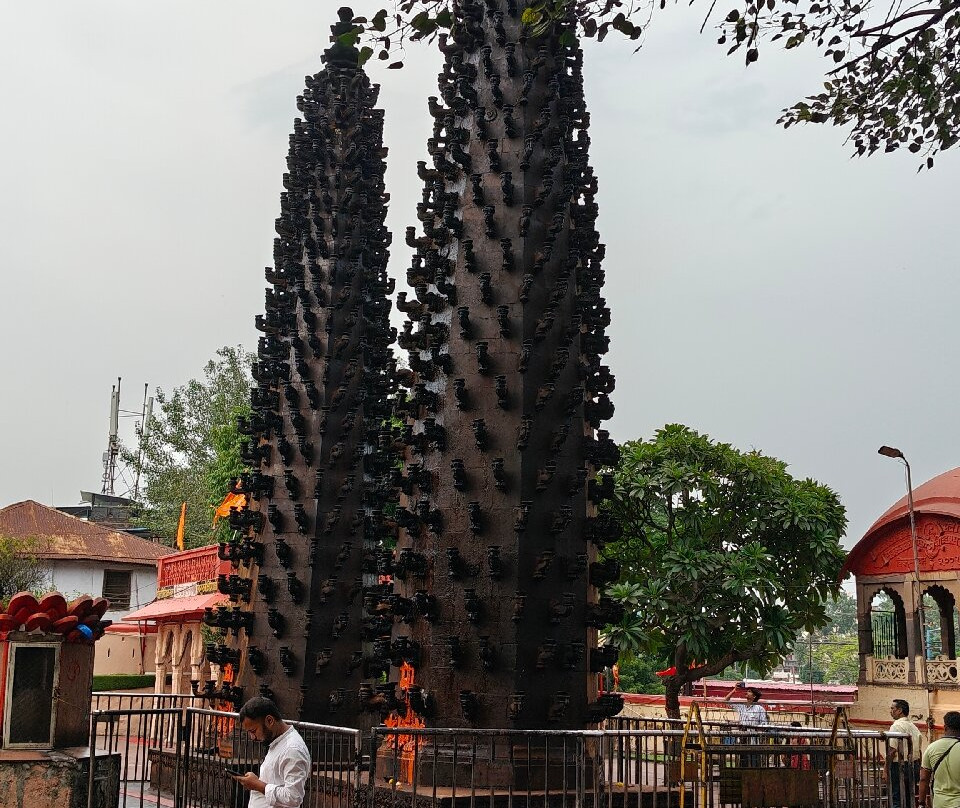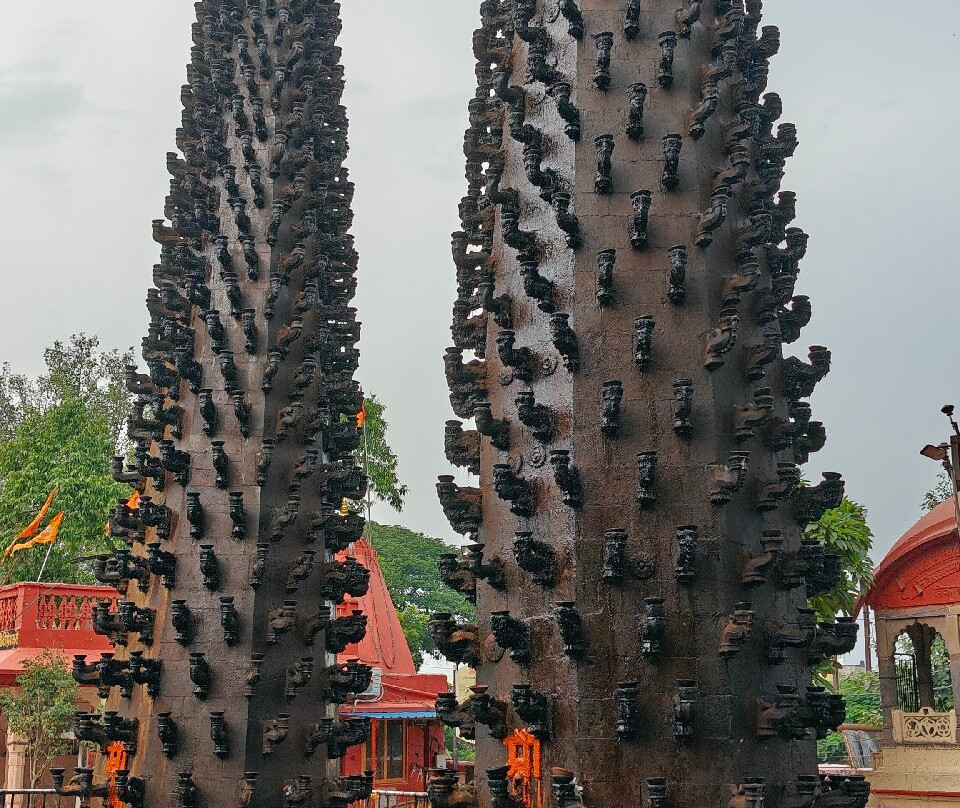的点评
Om Maha Lakshmi Om Maha Saraswati
Harsiddhi Temple的点评
点评:
This temple occupies a special place in the galaxy of ancient sacred spots of Ujjain. Seated between the idols of Mahalaxmi and Mahasaraswati, the idol of Annapurna is painted in dark vermilion color. The Sri Yantra, the symbol of power or shakti, is also enshrined in the temple.According to the Shiva Purana, when Shiva carried away the burning body of Sati from the sacrificial fire, her elbow dropped at this place. There is an interesting legend in the Skanda Purana about the manner in which the Goddess Chandi acquired the epithet of Harsiddhi. Once when Shiva and Parvati were alone on Mount Kailash, two demons Chand and Prachand tried to force their way in.Shiva called upon Chandi to destroy them which she did. Pleased, Shiva bestowed upon her the epithet of ‘one who vanquishes all’. The temple was reconstructed during the Maratha period and the two pillars adorned with lamps are special features of Maratha art. These lamps lit during Navaratri, present a glorious spectacle. There is an ancient well on the premises, and an artistic pillar adorns the top of it.
This temple occupies a special place in the galaxy of ancient sacred spots of Ujjain. Seated between the idols of Mahalaxmi and Mahasaraswati, the idol of Annapurna is painted in dark vermilion color. The Sri Yantra, the symbol of power or shakti, is also enshrined in the temple.According to the Shiva Purana, when Shiva carried away the burning body of Sati from the sacrificial fire, her elbow dropped at this place. There is an interesting legend in the Skanda Purana about the manner in which the Goddess Chandi acquired the epithet of Harsiddhi. Once when Shiva and Parvati were alone on Mount Kailash, two demons Chand and Prachand tried to force their way in.Shiva called upon Chandi to destroy them which she did. Pleased, Shiva bestowed upon her the epithet of ‘one who vanquishes all’. The temple was reconstructed during the Maratha period and the two pillars adorned with lamps are special features of Maratha art. These lamps lit during Navaratri, present a glorious spectacle. There is an ancient well on the premises, and an artistic pillar adorns the top of it.
翻译:
这座寺庙在乌贾因的众多古代圣地中占有特殊的地位。安纳普尔纳的雕像坐落在玛哈拉克西米和玛哈萨拉斯瓦蒂雕像之间,雕像涂成深朱红色。寺庙中还供奉着象征力量或沙克提的 Sri Yantra。根据《湿婆往世书》,当湿婆从祭祀之火中带走萨蒂燃烧的尸体时,她的手肘就落在了这个地方。《斯堪达往世书》中有一个关于女神旃蒂获得哈尔西迪称号的方式的有趣传说。有一次,当湿婆和帕尔瓦蒂独自在凯拉什山时,两个恶魔旃德和普拉昌德试图强行闯入。湿婆要求旃迪消灭他们,她照做了。湿婆很高兴,赐予她“征服一切的人”的称号。寺庙重建于马拉塔时期,两根饰有灯的柱子是马拉塔艺术的特色。这些灯在九夜节期间点亮,呈现出壮观的景象。寺庙内有一口古井,顶部装饰着一根艺术柱子。
这座寺庙在乌贾因的众多古代圣地中占有特殊的地位。安纳普尔纳的雕像坐落在玛哈拉克西米和玛哈萨拉斯瓦蒂雕像之间,雕像涂成深朱红色。寺庙中还供奉着象征力量或沙克提的 Sri Yantra。根据《湿婆往世书》,当湿婆从祭祀之火中带走萨蒂燃烧的尸体时,她的手肘就落在了这个地方。《斯堪达往世书》中有一个关于女神旃蒂获得哈尔西迪称号的方式的有趣传说。有一次,当湿婆和帕尔瓦蒂独自在凯拉什山时,两个恶魔旃德和普拉昌德试图强行闯入。湿婆要求旃迪消灭他们,她照做了。湿婆很高兴,赐予她“征服一切的人”的称号。寺庙重建于马拉塔时期,两根饰有灯的柱子是马拉塔艺术的特色。这些灯在九夜节期间点亮,呈现出壮观的景象。寺庙内有一口古井,顶部装饰着一根艺术柱子。
旅行类型:全家游




此点评仅代表旅行者个人的主观意见,并不代表TripAdvisor以及其合作方的意见。
关于我们
|
新闻动态
|
商务合作
|
会员中心
|
业主中心
|
业主通
|
常见问题
|
意见反馈
|
联系我们
|
营业执照
© 2025 Tripadvisor 版权所有。
使用条款 |隐私政策 |网站工作原理
部分照片由 VFM Leonardo 提供。
* Tripadvisor不是旅行社,也不是旅游预订服务代理商。我们提供免费、客观、公正的旅游资讯服务。 (显示更多)
TripAdvisor LLC 既不是预订代理商,也不是旅游运营商,不会向网站用户收取任何服务费。 按照规定,在 Tripadvisor 发布机票价格、游览和旅行套餐的合作伙伴(航空公司、旅行提供商及预订代理商),其标价须包含所有费用和附加费用。 例如, 机场出入境税费、消费税与其他服务费、手续费、杂费及附加费用。 当您向我们的某个合作伙伴进行预订时,请务必查阅他们的网站以了解当地行政部门要求的所有适用费用的具体情况。 除非另有说明,机票价格通常指的是一个人的价格(以人民币计)。
为方便起见,TripAdvisor LLC 根据从我们的预订合作伙伴获取的空房率计算每个酒店的均价。 对于游览和景点来说,所显示价格通常是每位成人的最低可用价格。 对于列出的任何旅行套餐或优惠,TripAdvisor LLC 无法保证任何特定的费率或价格。 此外,酒店均价每晚会更新,并以您的首选币种表示(使用现行汇率)。 由于这些已换算的价格是预估价格,因此,有关具体金额和币种请与预订网站进行核实。
此外,TripAdvisor LLC 无法保证我们网站上宣传的价格随时有效。 标价可能需要预订一定天数才能生效,或有不可用日期、使用条件或限制。
TripAdvisor公司对外部网站的内容一概不负责。优惠价格中不含税和其他费用。
ICP证:沪B2-20200433
沪ICP备20013175号
 沪公网安备31010502005427号
沪公网安备31010502005427号鹰程信息技术(上海)有限公司
货币/国家及地区
¥CNY
中国

